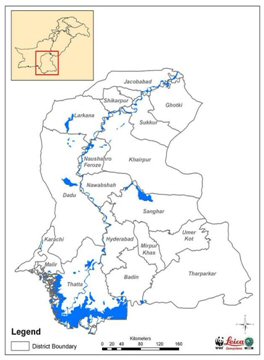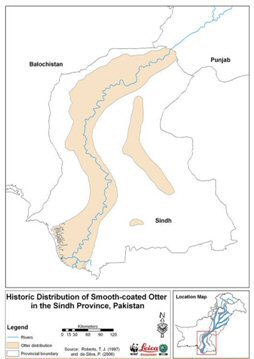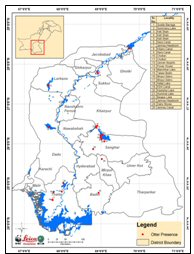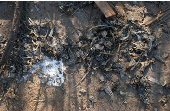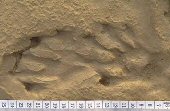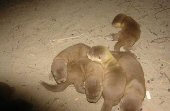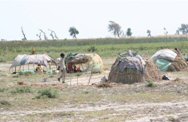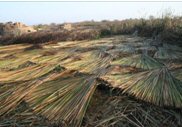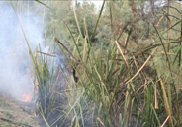 |
Last Update:
Thursday November 22, 2018
|
| [Home] |
Otter Conservation Project (OCP): The first phase of the Indus Eco-region Conservation Program of WWF-Pakistan, also known as the Indus for All Program, has prioritized three threatened wildlife species; Marsh crocodile (Crocodilus palustris), Hog deer (Axis porcinus) and Smooth coated otter (Lutrogale perspicillta) as species of special concern, and intends to conserve these species in the Indus eco-region through their protection, habitat restoration, relocation and management with the help of local communities and the Sindh Wildlife Department (SWD). In this context, Indus for All Program has funded a two year (October 2008 to September 2010) Otter Conservation Project (OCP) for SWD via its Partnership Fund. This article is based on the findings of surveys conducted jointly by SWD and WWF-P, Islamabad under the OCP during November 23 to December 04, 2008 and February 12 to 21, 2009. The Study Area: The study area is the Sindh province of Pakistan, comprising 23 districts, and is located in the southeastern part of Pakistan between latitudes N 23° and 28° and longitudes E 66° and 71°, covering an area of 140,914 km² (about 18% of the country’s total land) and a population of 42.4 million (about 23 % of country’s total population) (Government of Pakistan, 1998). It is bounded on its northwest by Baluchistan Province, on the northeast by Punjab Province, on the southern side by the Arabian Sea and towards the east by the Rajasthan and Gujrat states of India (Figure 1).
Physiography: The study area represents four geophysical parts, with the Khirthar mountain range on its west; a central plain bifurcated by Indus River, a desert belt at its east and the Indus delta on its south. The Indus River is regarded as the lifeline and backbone of the economy for the Province, fulfilling the irrigation and drinking water requirements of the Province, thus playing an important role in regulating the economy of the country (Akbar, 2008). Wetlands: In Sindh, there is a network of canals originating from three different barrages (Guddu, Sukkur and Kotri) on the Indus River. A large number of freshwater lakes and ponds of varying sizes are formed due to seepage of water along different canals and annual inundation of river water during the monsoon, and these provide suitable habitats for the Smooth coated otter (Akbar 2008). Vegetation: Four types of distinct ecosystems exist in the study area, i.e., tropical thorn forests, riverine, wetlands and coastal ecosystems (Akbar, 2008). Wildlife: Sindh, having diversified habitat types, hosts a huge variety of amphibian, reptilian, avian and mammalian fauna. Key mammalian species include Asiatic Jackal (Canis aureus), Wolf (Canis lupus), Striped hyena (Hyaena hyaena), Caracal (Felis caracal), Smooth coated otter (Lutrogale perspicillata), Hog deer (Axis porcinus), Sindh ibex (Capra aegagrus), Chinkara (Gazella bennettii), Indus dolphin (Platanista minor) amongst others. Otters: Pakistan is home to two species of otters: Smooth coated otter (Lutrogale perspicillata) and Eurasian otter (Lutra lutra). The Eurasian otter occurs in the northern mountainous region while the Smooth coated otter occurs in Sindh, Punjab and North West Frontier Province (NWFP) of Pakistan. The sub species found particularly along the Indus River has been referred as “Sindh otter“ (Lutrogale perspicillata sindica) (Pocock, 1939). It is known as “Oodh Balao” and “Paani ki Billee” (water cat) in Urdu language, “Ludhro” (singular) and “Ludhra” (plural) in Sindhi language, “Luddhar“ in Punjabi language and “Da Khwar Spay“ (water dog) in Pushto language in NWFP. Importance of the Smooth Coated Otter: Apart from its ecological role, the species has become a potential source of income for the local communities. An otter skin can fulfill the basic needs of a rural family for at least six months. Hundreds of nomadic people are involved in the illegal trade in wild animals and animal parts in the country; otter skin is amongst the highly priced wildlife products and fetches price ranging from Pak Rupees 30,000,- to 60,000,- (Khan et. al., 2008). This illegal practice, however, has put the otter population at risk. Objectives of the study: The objectives of the study included determining the otter population and its distribution, identification of potential habitats and understanding the potential threats to the species in Sindh province. REVIEW OF LITERATURE Many studies have been conducted on otters in different countries of the world. However, in Pakistan only a few workers have dealt with the otters. Khan and Hasnain (2008) estimated the population of Smooth coated otter around Keti Shah riverine forest in Sukkur district and in a part of Nara canal lying within Sanghar district in Sindh. A detailed literature review on Smooth coated otter has also been conducted by Khan et al. (2008) that contains information about previous studies on Smooth coated otter in relation to its nomenclature, status, distribution and geographical range, biology, habitat, behavior and ecology, ecological role, food and feeding habits, breeding, territory size and threats. Gachal et al. (2007) studied the physio-chemical parameters of water samples from two different sites in River Indus representing the otter habitats and found them contaminated and not suitable for otter existence. Ellerman and Scot (1951), Ellerman (1961) and Prater (1965) have confirmed the occurrence of this species in Pakistan. Various authors (Siddiqui, 1969; Ahmad and Ghalib, 1975; Roberts, 1997, 2005) described otter in their published material while discussing mammalian fauna of Sindh province. METHODOLOGY The study area represents different types of habitats and terrains comprising semi desert plains, cultivated lands, wild lands, river, barrages, canals, lakes, ponds and fish farms etc. Therefore, different direct and indirect methods were applied to find out the potential sites of the occurrence in the study area. Apart from gathering secondary information from published and unpublished reports about populations and distribution of otters in the study area, relevant people in different areas including the officials of SWD, WWF-P, Fisheries and Irrigation Departments, Fisher Folk Forum, local hunters, local fishermen, fish farmers, fish traders, boatmen and some political and influential people were contacted to obtain their views about existence of the otters in study area. Fish markets in different districts where the fishermen daily gather to sell their catch were also visited in order to listen to different fishermen and fish traders and to gather some information about the existence of the otter and problems for fishermen related to the otters. According to the information obtained through all the sources, 12 districts containing potential otter habitats were marked on a district map of the Sindh Province. Almost every possible potential otter site was visited for the confirmation of otter existence. Recent otter tracks, remains of eaten fish by otter, otter spraints and holts were the means to confirm the existence of otters. GPS coordinates at every site were recorded to develop the population distribution maps. Photographs of otter tracks, remains of eaten fish by otter, otter spraints and otter habitats were also taken. During the survey, an attempt was also made to estimate the existing population of Smooth coated otter in the study area. This population estimation was made by using Tracks Count Technique (Brower et. al., 1990) at five sites (site No. 3, 4, 5, 13 and 14; Table 3) while at rest of the 20 sites, the estimates were based only on interviews with locals, fishermen, fish farmers and hunters. Equipment and field kits used during the surveys included Digital camera (Canon EOS 30 D), search lights, measuring tape, binoculars (10 x 50), GPS (Garmin Map 76) and field guide books. RESULTS An area of about 5,000 km was traversed in 12 districts of Sindh. A total of 36 sites were visited to record the existence of otter, of which 25 sites in 11 districts were positive (Table 1). Historical Distribution of Smooth coated otter in Sindh Based on the available literature and personal communication with biologists, the historical distribution of Smooth coated otters in Sindh Province was plotted on a map (Figure 2). The wildlife conservation movement started in Pakistan during early 1970’s after the report about the WWF expedition to Pakistan (Mountfort and Poore, 1968) and the Wildlife Enquiry Committee Report under the Ministry of Agriculture and Works (Government of Pakistan, 1971). Results of the research conducted prior to this conservation movement in the country have been considered as historical data for plotting the distribution of the Smooth coated otters in the study area. According to these records, Smooth coated otters existed along the River Indus throughout the Sindh Province (Blanford, 1881; Murray, 1884) and in upper Sindh, lower Indus valley and eastern Nara (Pocock, 1939). According to Mountfort (1969) and WWF (1967) the Smooth coated otters existed in the Indus River in West Pakistan. Roberts (1977 revised edition in 1997) reported the existence of the species at Keti Bunder, Sindh coast, Sundari Lake and east Nara swamps and described its range beyond the lower Indus.
Current Distribution of the Smooth coated otter in Sindh Thirty-six sites in 12 districts in the study area were searched for evidence of the Smooth coated otter, and its existence was confirmed at 25 sites in 11 districts (Table 1; Figure 3).
Observation Records of Otter Only at one site (out of the 25) near the Power Hose in Chotiari Wetlands Complex (site No. 17), was the otter observed directly; a female with six newly born cubs (Figure 6). At the rest of the 24 sites, the existence of otters was confirmed on the basis of indirect evidence such as tracks, spraints, holts, remains of eaten fish by otter and interviews with locals, fishermen and fish farmers (Table 2; Figures 4 and 5). Estimated Otter Population The population of smooth coated otter was estimated around 178 (152 to 204) at all the sites where there were evidences of otter existence (Table 2). These estimates are based on Track Count Method at five sites (site No. 3, 4, 5, 13 and 14) while at the rest of 20 sites these depended on interviews. Potential Otter Sites Criteria were developed to identify the potential otter sites in the study area as follows.
Using these the selection criteria, out of the 25 sites, five (Nos. 1, 8, 13, 15 and 22) in four districts were identified as the potential sites (Table 3). Conservation Status of Smooth coated otter The Smooth coated otter is categorized as Near Threatened (IUCN Red List of Pakistan Mammals, 2005). Although it is protected (P) in Sindh under Sindh Wildlife Protection Ordinance 1972 and enlisted in Appendix II of the CITES Category 2007, the otter is considered to be on the decline due to habitat fragmentation, conflicts with fishermen and hunting for its pelt (Roberts, 1997; Gachal et al., 2007). Due to high levels of pollution in Hummal and Manchhar Lakes, the otter has almost disappeared from these two large lakes. The case of Keenjhar Lake is somewhat different, where increased human activities as a result of ill-planned tourism and over-fishing have forced the otters to leave. In Keenjhar Lake, the otter is still found and one animal was found dead in May 2008 on the nearby road, killed by a vehicle. In Chotiari Wetlands Complex, Typha cutting and burning of the undergrowth are the major factors that force the resident otter populations to move locally. THREATS TO SMOOTH COATED OTTER IN SINDH Major threats to Smooth coated otter identified during the study are discussed below: Otter Hunting for Fur Trade A nomadic tribe named differently in different areas in the country (Baagree, Oadh, Pakhee Waas, Changar), and working under the shelter and protection of some resourceful people and wildlife products dealers and traders, is the major culprit in otter skin trade (Fig. 7 and 8). More than 400 well-trained hunters belonging to this tribe are actively hunting wild animals in the country. According to the hunters there are two types of otters, a white and a dark one. The hunters are paid by the dealers or middlemen Rs. 12,000 to 15,000 (US $ 150 to 180) for the dark skin and Rs. 25,000 to 30,000 (US $ 312 to 375) for the white skin, whereas the middlemen earn from the traders Rs. 30,000 (US $ 375) for the dark skin and Rs. 60,000 (US $ 750) for the white skin. Unfortunately, no white skin was available.
Habitat Degradation The otter, being an amphibious animal, utilizes both water and land environments for its various activities and hence, both water and land collectively constitute its habitat. The aquatic part provides food, while the terrestrial part provides necessary shelter and refuge to the animal. Unfortunately, in the study both aquatic and terrestrial habitats of otter have seriously deteriorated because of: i. Water Pollution ii. Clearing of Vegetation Weak Enforcement of Wildlife Laws The decline in otter populations even in the presence of Sindh Wildlife Protection Ordinance 1972 suggests that the protection is not effective and there are gaps in the implementation of the wildlife laws (Shafiq, 2005). Poor law enforcement due for various reasons like lack of trained staff and funds is also contributing to the otter decline in the study area. Burning of Undergrowth Thick vegetation of Mesquite (Prosopis juliflora) in Chotiari Wetlands Complex is burnt dried annually by the local communities to have fuel wood as well as fresh grasses for their livestock (Fig. 12). These fires in otter habitat not only disturb the fauna of the area but also remove the refuge and shelter of the otter and force it to move to other areas at least for a short period of two to three months during the year.
Presence of hunting and feral dogs Hunting and feral dogs in the study area especially around Keenjhar Lake are a threat to otters especially the cubs. Tourism Thousands of tourists from Karachi, Hyderabad, Thatta and other cities visit Keenjhar and Haleji Lakes on weekly basis, and otter populations have been greatly affected at these two sites. According to the locals, about six to eight year back, the otter was commonly found around Keenjhar Lake but now it is difficult to locate. Dumping of polythene bags, plastic bottles, glass bulbs and other non-degradable wastes are some of the negative impacts associated with the tourism that affect the habitat quality. Keenjhar Lake, covering an area of 9,842 ha (98.42 km2), is a good income resource for fisherman of Thatta district where 10,766 fishermen with 1,205 boats are actively involved in fishing. The total annual fish catch from the lake has been reduced from 194,861 kg in 2001-02 to 27,351 kg in 2004-05 (Indus for All Program, 2006). These figures reflect the over-exploitation of the fisheries resources in the lake. Such anthropogenic activities encompassing over 10,000 fishermen and thousands of tourists at the lake on daily basis has adversely affected hthe otter population. Human-Otter Conflicts Many fish farmers and locals consider otters as pest and try to kill them whenever they get a chance. There are some reports of huge damage to fish stocks in fishponds and many fish farmers have closed their fish farms due to otters’ attacks on the fish stocks in their fish farms. Similarly, Typha and Saccharum sp. constituting the major part of otter habitat also provide a source of livelihood for the local communities in the study area. Therefore, upon utilization of common resources by both otters and human, there is serious conflict between the two. Competition for Food Fish provides food for both human and otters. There are hundreds of
small and large freshwater lakes in the study area, and many fish farms
in the area. People have also converted many of these natural freshwater
lakes into fish farms. Human occupancy on natural wetlands has also
created a difficult situation for otters who rely on natural wetlands
for food, and they have either to forage far away or to attack the
fish farms. Thus, otters in the study area do not have permanent refuge,
feeding and breeding grounds and have to move seasonally, which constitutes
a continuous disturbance for otters. DISCUSSION There are very few and insufficient data available from literature to compare the past and present status of Smooth coated otter in the study area, but after interviewing a number of people from all the 25 sites in the study area where the existence of otter was confirmed during the survey, it was found that the otter population is facing a decline. The main reasons for this are poor the economic condition of local communities, unemployment and lack of awareness about otters and to some extent, fish farming. High demand of otter skin in China and Tibet (IOSF 2008) and its high price (Khan et al., 2008) in the study area, and low risk for the hunters due to weak enforcement of wildlife laws, have encouraged otter hunting by the poor local communities. Once existing in vast areas almost all along Indus River and irrigation system in Sindh (Roberts, 1997; Khan and Hasnain, 2008), Smooth coated otters have been compelled now to live in scattered populations in fragmented habitats, and to keep moving for survival in the study area, due to habitat destruction through vegetation removal, water pollution and planned annual forest fires, over-hunting, lack of awareness and continuous and regular human intrusions/disturbances in otter habitats. Only five sites in the study area, out of 25 during the survey, were found to be the potential sites of the Smooth coated otter where it could be found through out the year, while rest of the 20 sites of otter existence were those visited by otters occasionally in different seasons. Despite all this, some of the local fishermen consider otter’s presence as a blessing as they get more fish trapped in their nets due to otter activity. Fishermen that used to keep otters as pets and as assistants for fishing in the past revealed that otter is a very intelligent and loyal animal and can be tamed in a short period of time. Breeding by Smooth coated otters and birth of the cubs may occur at any time throughout the year (Roberts, 1997; Foster-Turley, 1992). Litter size of 2 to 4 cubs is normal (Roberts, 1997), but during the survey six cubs were found with a mother at Chotiari Wetlands Complex in Sanghar District. According to fishermen and some hunters, six otter cubs per pregnancy are a common phenomenon. CONCLUSION The Smooth coated otter is an important ecological indicator of a healthy wetland and associated biodiversity, especially the fish fauna. Once distributed widely throughout Sindh, it exists in fragmented habitats in isolated populations now. If threats and stresses continue to exist, it will vanish. Hence, it is mandatory to conserve this species through restoration of its habitats, minimizing the threats and its relocation from sensitive to protected habitats. ACKNOWLEDGMENTS - A number of people from different government departments and non-government organizations including Fisheries Department, Pakistan Fisher Folk Forum, Sindh Rangers, District Government, Wildlife Department, Irrigation Department, Local Influential People, Local fishermen, fish farmers and hunters facilitated and supported our team during the survey. We are much obliged and grateful to all those people and sincerely acknowledge their assistance in this survey for Smooth coated otter in Sindh Province. We are also thankful to the Partnership Fund, Indus for All Program for providing financial support to the Otter Conservation Project. REFERENCES Ahmed, M.F., Ghalib, S.A. (1975). A
Checklist of Mammals of Pakistan. Rec. Zool. Surv. Pak. VII(1&2):1-34. Résumé : Une Enquete
sur la Loutre à Pelage Lisse (Lutrogale perspicillata
sindica)
dans la Province de Sindh, Pakistan. Resumen: Relevamiento
de Nutria de Río de Epelaje Suave (Lutrogale perspicillata
sindica) en Sindh, Provincia de Pakistán. |
| [Copyright © 2006 - 2050 IUCN/SSC OSG] | [Home] | [Contact Us] |










